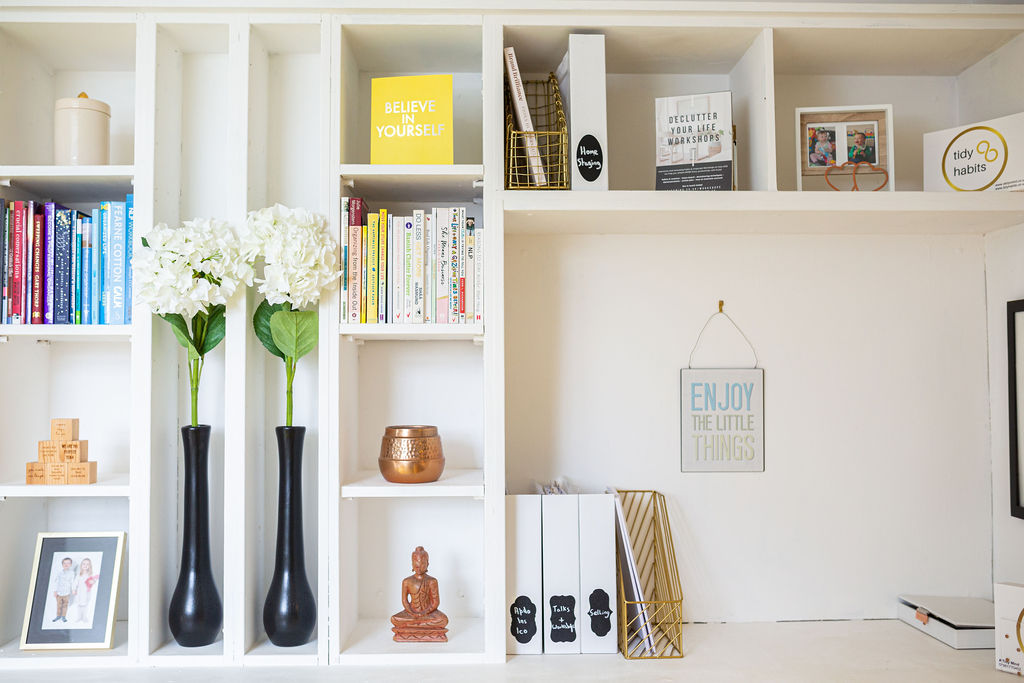Staying tidy with ADHD is possible by implementing structured routines, minimising clutter and using strategies tailored to your brain’s strengths. Many individuals with ADHD struggle with organisation due to challenges with attention regulation and executive function, but with the right approach, maintaining a tidy space becomes much easier.
Create Simple & Sustainable Routines
Routines help automate tidiness, reducing the mental effort required to stay organised. Keeping them simple ensures they are easy to maintain in the long term.
Start by creating a daily reset habit. Allocate 10 to 15 minutes each evening to tidy up key areas such as your desk, kitchen or bedroom.
Using timers or alarms can make this routine more structured and easier to stick to. Breaking tasks into small, manageable steps prevents them from becoming overwhelming.
Another effective strategy is the ‘one-minute rule.’ If a task takes less than a minute—like putting away shoes, throwing away rubbish or wiping down surfaces—do it immediately. This prevents mess from accumulating and makes tidying feel less daunting.
Declutter with Purpose
Clutter can be overwhelming and distracting, so minimising it makes staying tidy much easier. A streamlined space reduces decision fatigue and makes it easier to find things.
A great way to start decluttering is the ‘one category at a time’ approach. Instead of attempting to tidy an entire room at once, focus on a single type of item, such as clothes, books or paperwork. This prevents burnout and makes the process feel more manageable.
Additionally, creating designated storage solutions for frequently used items helps prevent clutter from returning. Clear, labelled bins or baskets make it easier to see where things belong, reducing the mental load of organising.
Use Visual & Physical Cues
People with ADHD often struggle with object permanence, meaning that if something is out of sight, it is out of mind. Using visual and physical cues can make tidying more intuitive and automatic.
Transparent storage containers and open shelving systems keep essential items visible while maintaining organisation. If an item has a specific place and can be easily seen, it is more likely to be put away correctly.
Another effective method is using colour-coded labels or signs. These provide clear reminders of where things belong, reducing the chances of misplacing important items. Visual cues create a structured environment that supports better tidiness habits.
Make Cleaning Enjoyable
Turning tidying into an enjoyable experience helps sustain motivation and consistency. Since ADHD brains respond well to stimulation, adding fun elements to the process makes it more engaging.
Pair tidying with music, podcasts or audiobooks to make it feel less like a chore. Upbeat music can boost energy levels, while an interesting podcast can make the time pass quickly.
Gamifying cleaning tasks is another great technique. Set a timer and challenge yourself to see how much you can clean before it runs out. Alternatively, use reward-based incentives, such as treating yourself to a break or a favourite snack after completing a cleaning task.
Invest in External Support
Seeking external support can ease the burden of tidying, especially during particularly busy or overwhelming periods. Sometimes, delegating or outsourcing certain tasks can make a significant difference.
Having an accountability partner, such as a friend or family member, can provide motivation and support. Setting up regular check-ins with someone who encourages you can help maintain progress.
For workspaces, investing in office cleaning services can be highly beneficial. A professional cleaning team ensures that the environment remains tidy and organised, reducing distractions and improving productivity.
Use ADHD-Friendly Organisation Tools
Certain organisational tools are particularly effective for individuals with ADHD, making tidiness more manageable and intuitive.
Using a whiteboard or sticky notes for reminders helps keep tasks visible and prevents forgetting important cleaning routines. Digital apps with reminders and scheduling features can also help create consistency.
Another useful tool is a ‘drop zone’ near the entrance of your home or workspace. Having a designated place for keys, bags and daily essentials prevents them from being misplaced and reduces clutter build-up.
Prioritise Mental Wellbeing
Since ADHD can make tidying feel overwhelming, it is essential to approach organisation with self-compassion. Viewing tidiness as a process rather than a rigid standard prevents frustration and discouragement.
One important factor is managing stress levels. Research shows that individuals with ADHD are three times more likely to experience anxiety, which can make organisation even harder. Practising stress-reducing activities such as mindfulness, exercise or deep breathing can make it easier to stay on top of tidying tasks.
Additionally, recognising and celebrating small wins is important. Even minor improvements in tidiness are steps towards better organisation and should be acknowledged.
Being kind to yourself throughout the process helps to build positive habits over time. ADHD therapy can also provide useful coping strategies for managing executive function challenges and staying organised.
The Bottom Line
Staying tidy with ADHD is achievable with the right strategies in place. By creating simple routines, reducing clutter, using visual cues and making cleaning enjoyable, organisation becomes easier.
Seeking external support and using ADHD-friendly tools further enhances tidiness. Most importantly, maintaining a compassionate approach ensures that tidying remains a sustainable and stress-free practice. With consistency and the right mindset, staying organised can become second nature.

